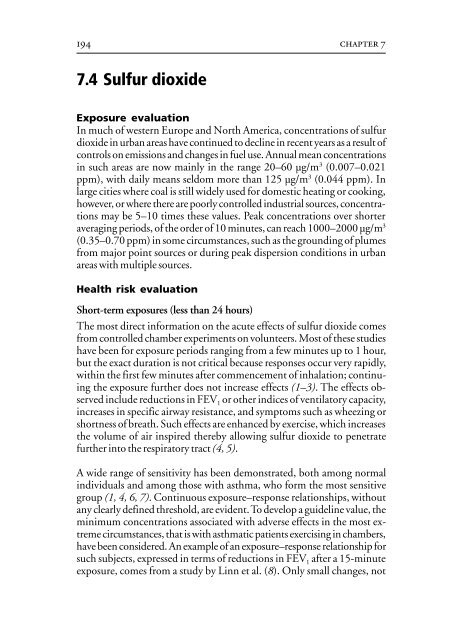Air Quality Guidelines - World Health Organization Regional Office ...
Air Quality Guidelines - World Health Organization Regional Office ...
Air Quality Guidelines - World Health Organization Regional Office ...
You also want an ePaper? Increase the reach of your titles
YUMPU automatically turns print PDFs into web optimized ePapers that Google loves.
194 chapter 7<br />
7.4 Sulfur dioxide<br />
Exposure evaluation<br />
In much of western Europe and North America, concentrations of sulfur<br />
dioxide in urban areas have continued to decline in recent years as a result of<br />
controls on emissions and changes in fuel use. Annual mean concentrations<br />
in such areas are now mainly in the range 20–60 µg/m 3 (0.007–0.021<br />
ppm), with daily means seldom more than 125 µg/m 3 (0.044 ppm). In<br />
large cities where coal is still widely used for domestic heating or cooking,<br />
however, or where there are poorly controlled industrial sources, concentrations<br />
may be 5–10 times these values. Peak concentrations over shorter<br />
averaging periods, of the order of 10 minutes, can reach 1000–2000 µg/m 3<br />
(0.35–0.70 ppm) in some circumstances, such as the grounding of plumes<br />
from major point sources or during peak dispersion conditions in urban<br />
areas with multiple sources.<br />
<strong>Health</strong> risk evaluation<br />
Short-term exposures (less than 24 hours)<br />
The most direct information on the acute effects of sulfur dioxide comes<br />
from controlled chamber experiments on volunteers. Most of these studies<br />
have been for exposure periods ranging from a few minutes up to 1 hour,<br />
but the exact duration is not critical because responses occur very rapidly,<br />
within the first few minutes after commencement of inhalation; continuing<br />
the exposure further does not increase effects (1–3). The effects observed<br />
include reductions in FEV 1 or other indices of ventilatory capacity,<br />
increases in specific airway resistance, and symptoms such as wheezing or<br />
shortness of breath. Such effects are enhanced by exercise, which increases<br />
the volume of air inspired thereby allowing sulfur dioxide to penetrate<br />
further into the respiratory tract (4, 5).<br />
A wide range of sensitivity has been demonstrated, both among normal<br />
individuals and among those with asthma, who form the most sensitive<br />
group (1, 4, 6, 7). Continuous exposure–response relationships, without<br />
any clearly defined threshold, are evident. To develop a guideline value, the<br />
minimum concentrations associated with adverse effects in the most extreme<br />
circumstances, that is with asthmatic patients exercising in chambers,<br />
have been considered. An example of an exposure–response relationship for<br />
such subjects, expressed in terms of reductions in FEV 1 after a 15-minute<br />
exposure, comes from a study by Linn et al. (8). Only small changes, not

















